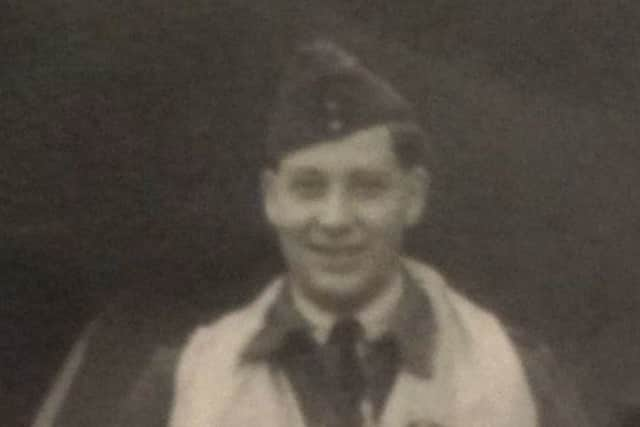Obituary: Alexander Reid Smith DFC


Sandy Smith spent his childhood on a farm in the lush Howe O’ The Mearns, the idyllic countryside that formed the backdrop to Sunset Song’s saga of tragedy, hope and grindingly hard life on the land.
The youngest of five children, his family history also had echoes of Lewis Grassic Gibbon’s fictional tale of heartache when his father died when he was just two, leaving his mother to raise the youngsters and run the farm on her own.
Advertisement
Hide AdAdvertisement
Hide AdBut the landscape of his life was to change even more dramatically when, after the outbreak of the Second World War, he joined the RAF and was ultimately attached to a Bomber Command squadron, flying night time raids over Germany as a Pathfinder, a corps d’elite whose gallantry is legendary.
The missions were amongst some of the most dangerous of the conflict, lighting the way amid ferocious flak for the bombers to successfully hit their targets. His courage with 128 Squadron earned him the Distinguished Flying Cross.
It could not have been further from his ambition, forged in that fertile corner of rural Scotland, to become a forester.
Born at Easthill Farm in Laurencekirk, the son of Thomas and Elsie Smith, despite the early tragedy in his life he excelled at Laurencekirk Primary school and became dux of his year at Stonehaven’s Mackie Academy in 1937. However, instead of going on to study forestry as he had wished, his mother decided that accountancy was much more fitting for a young man of his ability and he studied the subject in Aberdeen until Britain declared war on Germany.
His two elder brothers, Thomas and James, both served with the King’s African Rifles, while a third brother William kept the farm going. Meanwhile young Sandy joined the RAF in 1941 and was sent to train as a navigator in Canada and at the University of Miami in Florida, USA where he was described as “good in flight, exceptional in theory”. He was subsequently posted to 149 Squadron as navigator/bombardier, flying in heavy bombers over Europe in 1942 and 1943.
He then spent a spell on aircraft delivery duty until, at the beginning of 1945, he was transferred to No 8 (Pathfinder Force) Group based at RAF Wyton,
The Pathfinder Force (PFF) flying Wellingtons, Stirlings, Halifaxes and Lancasters, had originally been formed under the direct control of Air Chief Marshal Arthur “Bomber” Harris, with crews hand-picked for their navigational abilities, pluck and determination. All the airmen were volunteers and they hugely increased the success of precision night bombing missions by acting as a special marking force. But it soon expanded into a completely new group, re-equipped with Lancasters and Mosquitos.
The Mosquito squadrons of the Light Night Striking Force specialised in lightning nuisance attacks on German industrial centres and are best known for their contribution to the 36 successive night raids on Berlin in early 1945.
Advertisement
Hide AdAdvertisement
Hide AdIt was as one of the two-man crew of these Mosquitos that Smith ended his war, undertaking some of the most crucial and dangerous missions.
In March and April 1945 the shuttle bombing raids into Germany were relentless. His logbook records attacks on the cities of Wurzburg, Hamburg and Magdeburg, the naval base of Keil and on airfields at Maching and Schleissheim. One of his last was on the Pasing Transformer Station at Munich, less than a fortnight before the war in Europe drew to a close.
He had also flown in a Commodore flying boat and in Blenheim, Mitchell, Wellington, Stirling and Lancaster bombers and had been involved in photographic work. Immediately post-war he was transferred to 14 Squadron, carrying out courier runs from the UK to the Nuremburg War Crimes trials.
Flight Lieutenant Smith of the RAF Volunteer Reserve was awarded the DFC in 1945 and was demobbed in the summer of the following year.
After returning to Scotland he set up an accountancy business in Laurencekirk, working for local farmers in the area where he had grown up. Some time later, on a bus trip, he met his future wife Margaret, a police secretary. They married in 1961 and set up home in Laurencekirk, buying a site on the edge of a birch and beech grove, within walking distance of his office.
They played an active part in village social life where he audited the accounts of his local church for many years. A keen woodworker, he also enjoyed shooting, fishing, golfing and an annual holiday to Orkney as well as travelling as far afield as New Zealand.
Although he had once commented that he had been involved in the “re-shaping of Germany”, it wasn’t until he was in his 90s that his family discovered he had been decorated for bravery, a detail of which he had neglected to inform them.
Predeceased by his wife four years ago, he is survived by his nieces and nephews, Gillian, Tom, Sally, Angus and Frazer and extended family.